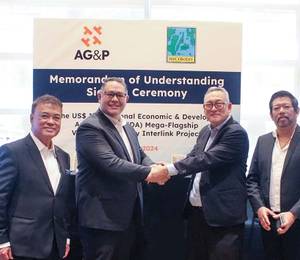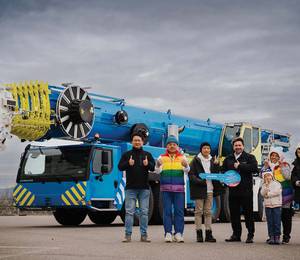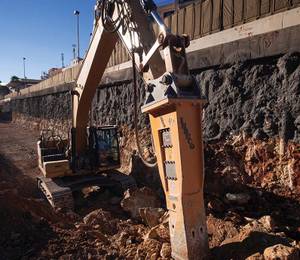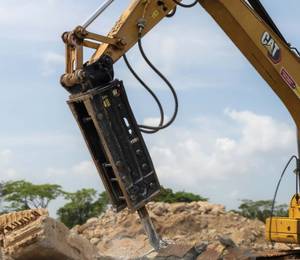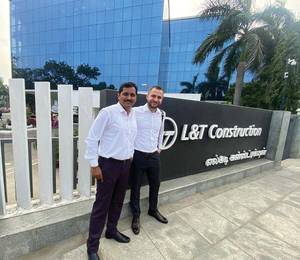Bali is Indonesia’s crown gem and a highly popular tourist destination. In some areas, the island is significantly developed, with luxury hotels lining its southernmost shores. However, its northern reaches are quieter and less trafficked by tourists – as well as have limited access to internet and cell communications.
To boost tourism on the north side of the island, Bali’s government commissioned PT Hutama Karya (Persero), a state-owned contractor charged with promoting Indonesian infrastructure, to build a major telecommunications tower in the Buleleng district. When completed, the 142-m Turyapada Tower will provide cell signal across much of Bali, including the Jembrana and Karangasem districts, as well as Buleleng. The tower’s signal range will reach 4.6 sq km.
In addition to enabling cell communications, digital television broadcasts and internet access, Turyapada Tower will be a new high-rise tourism destination. Its interior will include a planetarium, a skywalk, a rotating restaurant and a convention space. A museum that showcases Balinese technology and culture from various historical eras will also be a partner.
Positioned prominently atop a hill at 1,562 m above sea level, Hutama Karya believes that the Turyapada Tower’s visibility and striking design will make it an iconic, world-class tower, on the level of the Eiffel Tower, Tokyo Tower, or Macau Tower.
“Turyapada Tower, in our opinion, will be a new destination for tourism, creating job opportunities, promoting local business and attracting investment in North Bali,” said Robby Kurniawan, Hutama Karya’s building information modelling (BIM) manager who is overseeing the project.
Harnessing height
Choosing to build Turyapada Tower at a substantial elevation in Pegayaman Village, a highland area of Buleleng, had two major benefits: first, to maximise the reach of communication signals emitting from the tower, and second, to make the tower a more visible landmark. However, the site also came with its challenges.
“We faced steady rain and extreme weather changes that had the potential to delay construction progress,” said Mr Kurniawan. In this area, fog frequently rolls in and disappears without warning, and winds sweep through at velocities of up to 35 km an hour. Additionally, the steep mountain site only had narrow road access, making it difficult to mobilise heavy equipment and materials.
To mitigate these challenges during the initial planning phases, Hutama Karya used drones to map the area. The team processed the data collected through unmanned aircraft systems (UAS) with Bentley’s reality and spatial monitoring software. This information was then embedded into Hutama Karya’s existing GIS dashboard so that project managers could review the project in real time, whether they were present on site or working remotely.
As construction commenced, Hutama Karya also leaned on Bentley’s infrastructure construction management software to digitise project processes. Bentley’s 4D modelling solution facilitated the modelling of multiple interactive simulations of different work method scenarios, offering a visual representation of how each option could impact the project schedule depending on variables like weather changes. The software also has precise measurement capabilities for assessing the slope and contour of mountainous terrain, which enabled the team to avoid slippage and accidents while using heavy equipment.
Hutama Karya saw significant benefits, including improved project outcomes, reduced cost and enhanced collaboration across disciplines – all while creating sustainable and resilient infrastructure. “The engineering team’s plan optimised the project and gained us an efficiency of 61 days and helped us avoid potential delays, saving around US$82,000,” said Adi Zulhadi, a site engineering manager for the project.
‘Tri Hita Karana’
While creating a tourism draw in Bali, Hutama Karya needed to be careful to adhere to ‘Tri Hita Karana,’ the Balinese spiritual philosophy of maintaining harmony among God, people and nature. This philosophy guided the project’s environmental priorities as the team worked to minimise ecological impacts and avoid disrupting sacred Balinese sites.
With efficiencies gained in Hutama Karya’s planning process, the team was able to reduce expected carbon emissions by nearly 14%. This achievement also aligned with Indonesia’s current sustainable development goals, a set of targets for the country to adhere to as it undergoes the most rapid growth and development of any time in its history. These goals champion green energy promotion and environmental protection alongside efforts to add good jobs and advanced infrastructure to Indonesia – objectives that Mr Kurniawan believes the Turyapada Tower embodies.
“This project has the potential to make a positive impact,” said Mr Kurniawan. “The tower supports telecommunication by evenly distributing broadcasts in North Bali. Thus, the development of Turyapada Tower can support the economic growth as well as improving sustainability and tourism in North Bali.”
Image: PT Hutama Karya (Persero)
